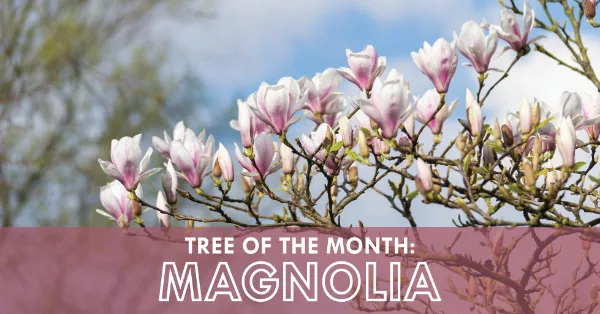Tree of the Month: Magnolia

Magnolias are the quintessential trees of the south. The evergreen broadleaves are hardy, attractive, and can grow more than 60 feet in height and 30 feet in width. Magnolia blossoms are fragrant and iconic and the trees can survive the oppressive heat of the American South with ease.
About Magnolias
Trees of the genus magnolia have been around for a long time, with fossilized blooms being dated as far back as 20 million years. Some theorize that the age of the genus coupled with the fact that its buds are encased in bracts rather than sepals makes the magnolia one of the first plant varieties to begin encouraging pollination.
Several species of magnolia can be found around the world, including France and East Asia, but magnolia grandiflora is the species associated with the Deep South. Magnolia grandiflora is characterized by wide, waxy, rigid leaves and a wide bowl-shaped flower.
Magnolia grandiflora is a cultural symbol of the South with a range from East Texas to Georgia and Florida. It is the state tree of both Louisiana and Mississippi, where the trees have been known to grow ponderously large, with the largest recorded individual reaching 121 feet in height.
The timber is hard and heavy and is often used in furniture. Magnolias are a decorative symbol of southern nostalgia and have been planted in yards and along streets in cities like Mobile Ala., Charleston, S.C., Jackson, Miss., and most notably New Orleans.
Caring For Magnolias
Pruning
Pruning a magnolia is rarely necessary unless you choose to remove inconvenient and low-hanging branches.
Watering
Magnolias thrive in rich soil that drains well and should be regularly and deeply watered but not allowed to stand in water. Magnolias develop root systems more quickly in cool weather, so fall is the best time to plant and water.
Magnolia Diseases and Pests
Magnolias are almost never troubled by pests and are only occasionally bothered by disease, making them a popular low-maintenance tree. The only disease that regularly afflicts magnolias is an iron deficiency called chlorosis, identified by the yellowing of leaves (though the veins remain green). It is easily treated by iron chelate, available at most nurseries and garden stores.
Magnolias are low-maintenance, though they require a lot of space, so don’t plant one too close to any structure. Varieties besides magnolia grandiflora thrive in regions outside of the south, so don’t shy away from this lovely tree if you live in other parts of the country.
If you’re interested in adding a magnolia to your property (and we think they’re a worthy addition) or you are interested in other tree services for your landscaping, contact The Grounds Guys today.
Further reading:
 Click to call
Click to call


